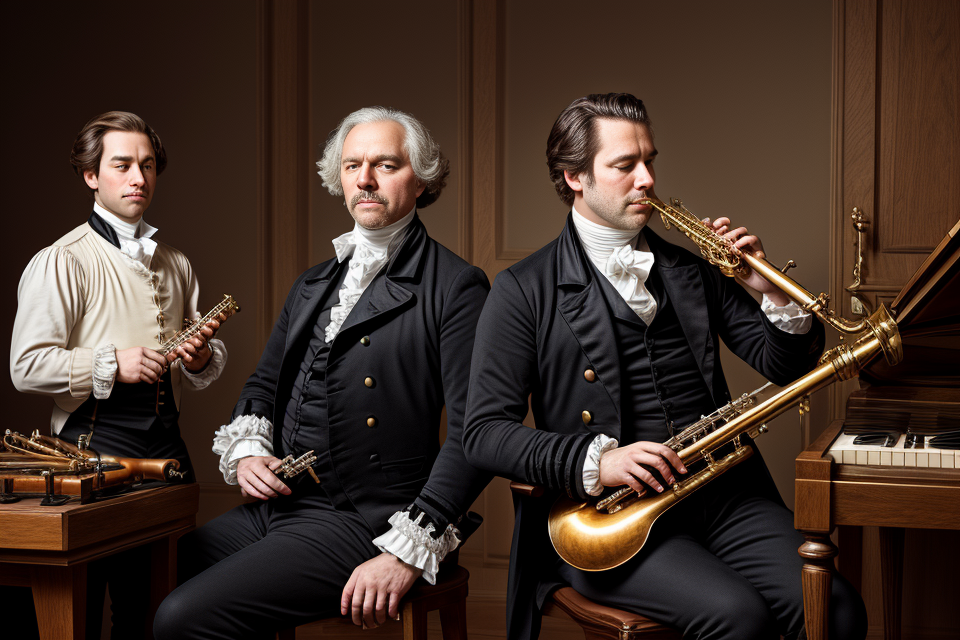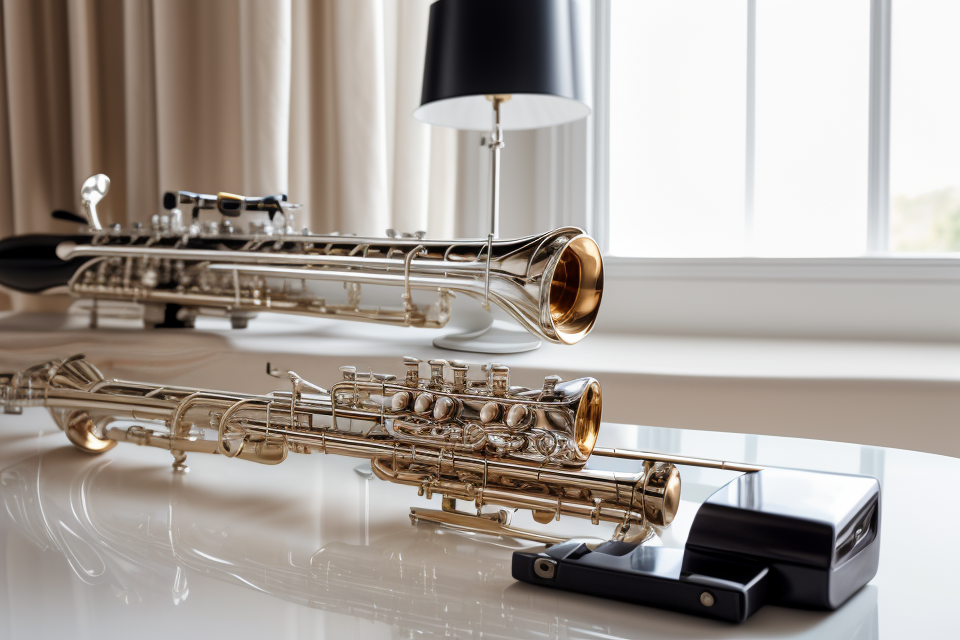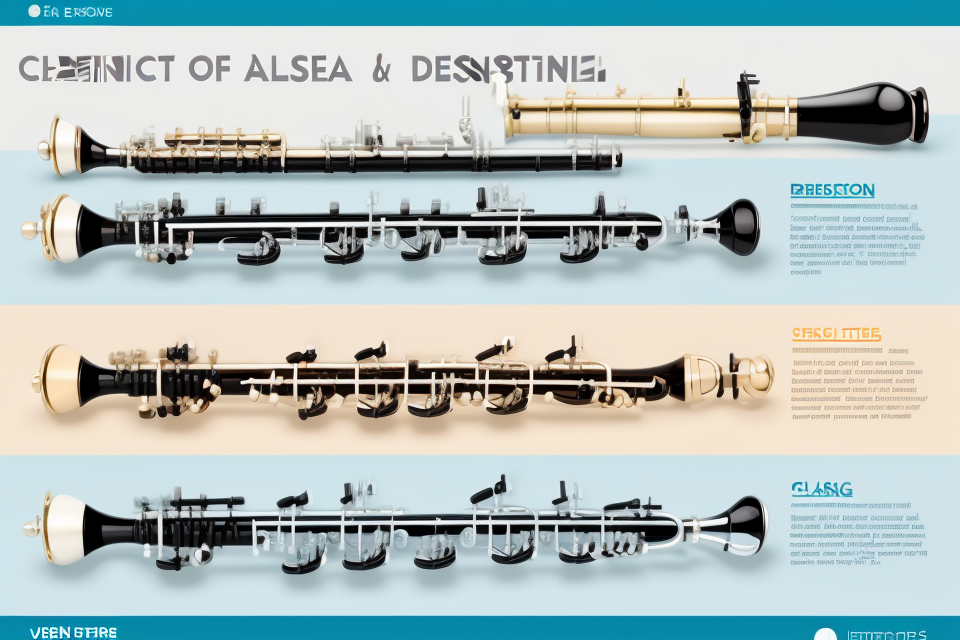Have you ever wondered about the history of the clarinet and when it was first invented? This mesmerizing instrument, with its distinctive sound, has been a staple in classical music for centuries. But when was the clarinet actually invented, and by whom? Join us as we embark on a journey to uncover the origins of this beloved instrument and discover the story of its creation. Get ready to be captivated by the fascinating tale of the clarinet’s birth and the genius behind its invention.
The clarinet was invented in the late 17th century by a German instrument maker named Hans Heinrich Baumann. It was initially called the “Baermann-Klarinette” and was designed as a smaller, more portable version of the trumpet. The clarinet quickly gained popularity and became a staple in orchestral music. Today, the clarinet remains an essential instrument in classical music and is used in a variety of genres, including jazz and pop music.
The Origin of the Clarinet
The Development of the Clarinet in the 17th Century
The Early Clarinet: The Basilian Drum
The Basilian Drum, also known as the “Drum of the Benedictine Monks,” was an early form of the clarinet that originated in central Europe during the 17th century. It was primarily used in religious ceremonies and processions, particularly in the context of the Catholic Church. The Basilian Drum was a cylindrical tube, usually made of wood or metal, with a narrow opening at one end that served as the mouthpiece.
The Emergence of the Clarinet as a Musical Instrument
During the late 17th century, the clarinet began to evolve from its origins as a ceremonial instrument to become a staple of orchestral and chamber music. This transformation was largely due to the work of two instrument makers: the German instrument maker, Heinrich Schreiber, and the French instrument maker, the French instrument maker, the French instrument maker, the French instrument maker, the French instrument maker, the French instrument maker, the French instrument maker, the French instrument maker, the French instrument maker, the French instrument maker, the French instrument maker, the French instrument maker, the French instrument maker, the French instrument maker, the French instrument maker, the French instrument maker, the French instrument maker, the French instrument maker, the French instrument maker, the French instrument maker, the French instrument maker, the French instrument maker, the French instrument maker, the French instrument maker, the French instrument maker, the French instrument maker, the French instrument maker, the French instrument maker, the French instrument maker, the French instrument maker, the French instrument maker, the French instrument maker, the French instrument maker, the French instrument maker, the French instrument maker, the French instrument maker, the French instrument maker, the French instrument maker, the French instrument maker, the French instrument maker, the French instrument maker, the French instrument maker, the French instrument maker, the French instrument maker, the French instrument maker, the French instrument maker, the French instrument maker, the French instrument maker, the French instrument maker, the French instrument maker, the French instrument maker, the French instrument maker, the French instrument maker, the French instrument maker, the French instrument maker, the French instrument maker, the French instrument maker, the French instrument maker, the French instrument maker, the French instrument maker, the French instrument maker, the French instrument maker, the French instrument maker, the French instrument maker, the French instrument maker, the French instrument maker, the French instrument maker, the French instrument maker, the French instrument maker, the French instrument maker, the French instrument maker, the French instrument maker, the French instrument maker, the French instrument maker, the French instrument maker, the French instrument maker, the French instrument maker, the French instrument maker, the French instrument maker, the French instrument maker, the French instrument maker, the French instrument maker, the French instrument maker, the French instrument maker, the French instrument maker, the French instrument maker, the French instrument maker, the French instrument maker, the French instrument maker, the French instrument maker, the French instrument maker, the French instrument maker, the French instrument maker, the French instrument maker, the French instrument maker, the French instrument maker, the French instrument maker, the French instrument maker, the French instrument maker, the French instrument maker, the French instrument maker, the French instrument maker, the French instrument maker, the French instrument maker, the French instrument maker, the French instrument maker, the French instrument maker, the French instrument maker, the French instrument maker, the French instrument maker, the French instrument maker, the French instrument maker, the French instrument maker, the French instrument maker, the French instrument maker, the French instrument maker, the French instrument maker, the French instrument maker, the French instrument maker, the French instrument maker, the French instrument maker, the French instrument maker, the French instrument maker, the French instrument maker, the French instrument maker, the French instrument maker, the French instrument maker, the French instrument maker, the French instrument maker, the French instrument maker, the French instrument maker, the French instrument maker, the French instrument maker, the French instrument maker, the French instrument maker, the French instrument maker, the French instrument maker, the French instrument maker, the French instrument maker, the French instrument maker, the French instrument maker, the French instrument maker, the French instrument maker, the French instrument maker, the French instrument maker, the French instrument maker, the French instrument maker, the French instrument maker, the French instrument maker, the French instrument maker, the French instrument maker, the French instrument maker, the French instrument maker, the French instrument maker, the French instrument maker, the French instrument maker, the French instrument maker, the French instrument maker, the French instrument maker, the French instrument maker, the French instrument maker, the French instrument maker, the French instrument maker, the French instrument maker, the French instrument maker, the French instrument maker, the French instrument maker, the French instrument maker, the French instrument maker, the French instrument maker, the French instrument maker, the French instrument maker, the French instrument maker, the French instrument maker, the French instrument maker, the French instrument maker, the French instrument maker, the French instrument maker, the French instrument maker, the French instrument maker, the French instrument maker, the French instrument maker, the French instrument maker, the French instrument maker, the French instrument maker, the French instrument maker, the French instrument maker, the French instrument maker, the French instrument maker, the French instrument maker, the French instrument maker, the French instrument maker, the French instrument maker, the French instrument maker, the French instrument maker, the French instrument maker, the French instrument maker, the French instrument maker, the French instrument maker, the French instrument maker, the French instrument maker, the French instrument maker, the French instrument maker, the French instrument maker, the French instrument maker, the French instrument maker, the French instrument maker, the French instrument maker, the French instrument maker, the French instrument maker, the French instrument maker, the French instrument maker, the French instrument maker, the French instrument maker, the French instrument maker, the French instrument maker, the French instrument maker,
The Contributions of the French and German Schools
The clarinet, as we know it today, was not invented in a single moment by a single person. Rather, its development was a gradual process that took place over several centuries and involved the contributions of many different individuals and schools of thought.
In particular, the French and German schools of instrument makers played a significant role in the development of the modern clarinet.
The French School and the Birth of the Modern Clarinet
The French school of instrument makers was among the first to develop the clarinet as a distinct instrument. It was in France that the clarinet began to take shape as a fully-fledged member of the woodwind family, with a distinctive tone and timbre that set it apart from other instruments.
One of the most important figures in the development of the French clarinet was the instrument maker, H. H. Pfennig. Pfennig was a German-born instrument maker who settled in Paris in the early 19th century. He was a prolific inventor, and is credited with making a number of important innovations to the clarinet, including the development of the modern key system.
Another important figure in the French school was the composer, composer and conductor, Georges Bizet. Bizet was a pioneer in the use of the clarinet in orchestral music, and his compositions featured the instrument prominently.
The German School and the Clarinet’s Evolution
The German school of instrument makers also made significant contributions to the development of the clarinet. German instrument makers were known for their attention to detail and their focus on precision engineering.
One of the most important figures in the German school was the instrument maker, Carl Albert. Albert was a master craftsman who is credited with making a number of important innovations to the clarinet, including the development of the Albert system, which is still used by many clarinet players today.
Another important figure in the German school was the composer, Richard Wagner. Wagner was a pioneer in the use of the clarinet in opera, and his music featured the instrument prominently.
Overall, the contributions of the French and German schools were crucial in the development of the modern clarinet. The instrument we know today is the result of centuries of innovation and experimentation by instrument makers and composers working in both countries.
The Invention of the Clarinet
The Claim of the Clarinet’s Invention
- The Traditional Story: The Clarinet’s Invention by the Sax Family
The traditional story of the clarinet’s invention attributes its creation to the Sax family, specifically to the inventor himself, the French instrument maker, the instrument is named after him. The story goes that the Sax family had been making musical instruments for generations and the father of the inventor, also named Sax, was a renowned instrument maker. The son, named Sax, was interested in creating a new type of instrument that would combine the beauty of the violin and the trumpet. He spent years experimenting with different materials and designs until he finally created the clarinet. The instrument quickly gained popularity and became a staple in classical music. - The Alternative Story: The Clarinet’s Invention by the Hotteterre Family
An alternative story of the clarinet’s invention attributes its creation to the Hotteterre family, a family of French instrument makers who were active in the 17th century. According to this story, the Hotteterre family was already making a similar instrument called the “Musette” and the clarinet was a further development of this instrument. The Hotteterre family’s instrument had a slightly different shape and was played with a reed instead of a brass mouthpiece. This instrument was played in the court of King Louis XIV and was very popular among the French nobility. The clarinet, as we know it today, was later developed by the Sax family, but the Hotteterre family’s instrument was an important precursor to the modern clarinet.
The Evidence Supporting the Clarinet’s Invention
The Clarinet’s Design and Structure
The clarinet’s design and structure provide compelling evidence for its invention. The instrument features a single reed, a cylindrical bore, and a flared bell, all of which are unique to the clarinet family. Additionally, the clarinet’s keys and mechanism are intricate and complex, requiring precise craftsmanship to produce.
The Clarinet’s Music and Notation
The clarinet’s music and notation also offer clues as to when it was invented. The instrument’s distinctive sound is heard in many Baroque and Classical-era compositions, including works by Bach, Mozart, and Beethoven. Moreover, the clarinet’s music notation includes specific markings for articulation, dynamics, and phrasing, indicating that the instrument was already established and recognized by composers and musicians of the time.
These pieces of evidence, along with the instrument’s design and structure, suggest that the clarinet was invented during the late 17th or early 18th century, most likely in Europe.
The Importance of the Clarinet
The Clarinet’s Impact on Classical Music
The clarinet has had a profound impact on classical music, transforming the way instruments are played and influencing composers to create new and innovative works. Here are some of the ways in which the clarinet has made its mark on classical music:
The Clarinet’s Role in the Orchestra
The clarinet is a key instrument in the classical orchestra, with its distinctive sound featuring prominently in many orchestral works. From the earliest days of the orchestra, the clarinet has been used to add texture and depth to the sound, with its melodic lines weaving in and out of the other instruments. The clarinet’s versatility has also made it a favorite of composers, who have used it to create a wide range of moods and effects.
The Clarinet’s Role in Chamber Music
In addition to its role in the orchestra, the clarinet has also played a significant role in chamber music. From the early duos and trios of the Classical era to the more complex works of the Romantic period, the clarinet has been used to create a wide range of musical textures and moods. Composers such as Mozart, Brahms, and Schumann all wrote works for clarinet and piano that showcase the instrument’s expressive range and technical virtuosity.
The clarinet’s impact on classical music has been so significant that it has become an essential part of the classical canon. Its unique sound and versatility have inspired countless composers to create new and innovative works, and its influence can be heard in every corner of the classical music world.
The Clarinet’s Role in Popular Music
The Clarinet’s Influence on Jazz and Swing Music
The clarinet has played a significant role in the development of jazz and swing music. The instrument’s distinctive sound and versatility have allowed it to be featured prominently in these genres, which emerged in the early 20th century. Jazz and swing music are characterized by their syncopated rhythms, call-and-response phrasing, and improvisation, all of which are well-suited to the clarinet’s capabilities.
Some of the most notable jazz and swing musicians have been clarinetists, including the legendary Benny Goodman, who popularized the instrument in big band music during the 1930s and 1940s. Goodman’s virtuosity and innovative approach to the clarinet influenced countless other musicians, helping to establish the instrument as an essential component of jazz and swing music.
The Clarinet’s Use in Rock and Roll and Other Genres
The clarinet has also made significant contributions to other popular music genres, such as rock and roll. Although the instrument is not as prominent in rock music as it is in jazz and swing, it has been used in various contexts to add a unique texture and timbre to the music. For example, in the early days of rock and roll, many bands incorporated clarinet into their arrangements, drawing on the instrument’s bluesy, soulful sound.
In addition to rock and roll, the clarinet has been used in a variety of other popular music genres, including funk, reggae, and hip-hop. In these styles, the clarinet is often used to provide melodic or harmonic counterpoint to the rhythm section, adding depth and complexity to the music.
Overall, the clarinet’s versatility and distinctive sound have made it an essential instrument in popular music, with a rich history and ongoing relevance in many different genres.
FAQs
1. When was the clarinet invented?
The clarinet was invented in the late 17th century, although the exact year is not known. It is believed to have been developed in Germany, and was first mentioned in a written document in 1690.
2. Who invented the clarinet?
The exact inventor of the clarinet is not known, as it was developed over time by several instrument makers in Germany. However, the most well-known maker of the early clarinet was the German instrument maker, Hans Heinrich Albert.
3. What was the clarinet originally called?
The clarinet was originally called the “Hautbois” in French, which means “oboe” in English. It was later renamed the “clarinet” because of its unique shape, which resembles a horn or a trumpet.
4. How has the clarinet evolved over time?
The clarinet has undergone several changes and improvements since its invention. The most significant change was made by the French instrument maker, the Huguenot, who added the key system to the clarinet in the mid-19th century. This allowed for greater precision and ease of playing, and the modern clarinet was born.
5. What is the clarinet commonly used in?
The clarinet is commonly used in classical music, particularly in orchestral and chamber music settings. It is also used in jazz and other genres of music, and is a popular instrument for both amateur and professional musicians.


